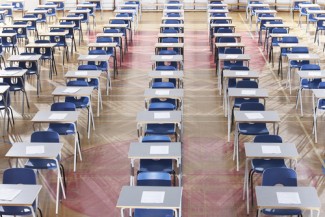Lowest bar pass rate for California in 67 years; other states see drop, too

Image from Shutterstock.
Only 40.7 percent of the people who took the California July 2018 bar exam passed, according to a state bar news release.
Comparatively, the state’s overall pass rate for the July 2017 bar exam was 49.57 percent. For July 2016, the overall pass rate was 43.57 percent.
A total of 8,071 applicants completed the July 2018 California exam, according to the news release, which was posted Friday. There were 5,132 first-time test takers, and that pass rate for that group was 55 percent. Out of 2,939 repeat test takers, the pass rate was 16 percent.
The overall pass rate for California is the lowest it has been in 67 years, the Recorder reports.
In September, the National Conference of Bar Examiners announced that the average Multistate Bar Exam score for July 2018 was 139.5, which is the lowest it’s been since 1984. That led to predictions—which for the most part were accurate—of lower pass rates overall for the July 2018 exam.
Connecticut appears to have one of the biggest decreases, with a 55 percent pass rate for July 2018, compared to 70 percent in July 2017. And the New Mexico bar passage rate for July 2018 was 70 percent, compared to 83 percent in July 2017.
Besides California and Connecticut, other states with bar pass rates below 60 percent for July 2018 include Alaska (56 percent), Nevada (57 percent) and New Jersey (58.83 percent), as well as Arizona and Maryland, which both had bar passage rates of 59 percent.
New York, which like California is seen as a state with a more difficult bar exam, had a pass rate of 63 percent for July 2018, compared to 68 percent in July 2017.
Admitting law students with below-average LSAT scores and undergraduate GPAs, along with accusations that people don’t study enough for the bar, are often listed as reasons why pass rates have dropped. What should be considered—but often is not—is that rote memorization is needed to pass a bar exam, and many new law graduates didn’t grow up with educations that focused on that skill, compared to prior generations, says Andrea A. Curcio, a professor at the Georgia State University College of Law, whose academic work includes examining law school learning assessments.
Having some sort of license exam to practice law is important, Curcio says, but she’d like to see the exams better reflect skills needed to practice law. She mentions giving applicants fact packets with cases and asking them to identify which cases would be the most helpful to the party’s claim.
“If the goal is the ability to apply doctrine, which I think it is, there are ways to do that without requiring you to first memorize the doctrine. Also, there are ways to test strategic thinking, how lawyers use the law, and where you find these facts,” Curcio says. “There is a potential crisis brewing if we have an exam that continues to just test pure doctrinal knowledge.”
Sara Berman, director of programs for academic and bar success at the AccessLex Institute, says there are many ideas about why bar pass rates are declining, but most of the theories are based on anecdotal information. Her organization started a bar exam research-grant program this year, which includes collaboration with the Law School Survey of Student Engagement. Among the groups conducting research for the program are the California bar and the Institute for the Advancement of the American Legal System.
“The [pass rate] drop from 2017 to 2018 was alarming,” Berman says. “I think the study will really help us to access whether the bar exams are aligning with the needs of future lawyers and will help us produce better lawyers.”
Updated on Nov. 20 to state the correct first-time pass rate for test takers of the July 2018 California bar exam.



